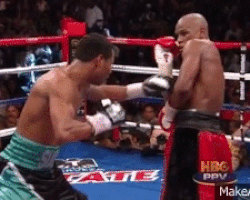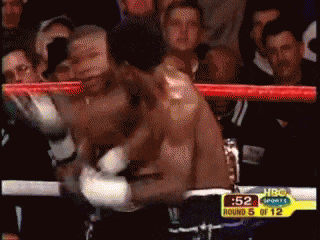Does spinning around yourself help reduce the dizziness from a punch on the jaw?
Martial Arts Asked by Ahmad Maqsodi on October 22, 2021
Does spinning around yourself
- help reduce the dizziness from a punch on the jaw, and
- prevent getting knocked out easily?
3 Answers
Not "spinning around", but "Rolling with the Punches"
I think the term you are looking for is "rolling with the punches" (widely known as the "shoulder roll").
When you roll with the punches, you effectively reduce the impact of those punches by a decent amount. But note that you cannot just stand there and roll (or spin) your head from side to side with incoming punches — you must roll your shoulder too to make this defensive maneuver effective.
When you roll with the punches, the chance of a knock-out is reduced (but I don't have a study to cite on this):
First, you have seen or anticipated the punch. This means that your neck, jaw, and shoulder muscles are all bracing for an impact. In this case, a knockout is unlikely. It is usually the punch that you don't see, or you don't anticipate, that knocks you out. It doesn't have to be the strongest punch; it can be a short, quick left hook — one that you didn't see.
Second, if you roll correctly, the punches are likely to hit your upper shoulder and get deflected. This means you don't get hit directly in your chin with the full force. The power of the punch is reduced and it is deflected.
Remember, your eyes play an important part in this. You should keep your eyes on your opponent even when you roll, otherwise you will soon find your head spinning like crazy.
To answer your question (assuming I understand it correctly), rolling with the punches, or using the shoulder roll, effectively reduces the damage. Without the full sting behind the punches, you are likely to feel less dizzy. You also need to pay attention to your stance. If you have a solid stance, your body will brace some of the hard punches when they land. But if your fighting stance is poor, every shot that lands will make you feel dizzy; your head will be spinning out of control and you won't be able to get your offense going.
The Art of Rolling: Turning Defense into Offense
Boxing:
The shoulder roll can be effectively used to turn a defensive position into an offensive move. Look at the first gif of Floyd. He rolls with the right cross. Floyd's shoulder deflects the punch, making his opponent's weight and momentum go further than was intended. This left a big opening in his opponent's guard, which Floyd brilliantly exploits and lands a clean right cross. There are many, many other instances of getting brilliant counter attacks off the shoulder roll; see YouTube.
Kickboxing:
In Kickboxing/Muay Thai, we don't use the shoulder roll like this. In kickboxing, a roll like this would mean a devastating follow-up roundhouse kick to the face. A shoulder roll would also leave many other spots vulnerable to kicks (e.g., the front leg and the ribs). Instead, in kickboxing, what we do is we absorb the punch in two different ways.
First, we take the punch and simultaneously step or hop backwards. It is extremely difficult to do. I have seen only a few people who are able to do it. Saenchai is one of them. You need a lot of experience to make that quick split-second decision to move back upon realizing your face has made contact with a punch. You have absolutely no time to "think" of doing this move. You just do it: instinct. I guess this is one of the things Bruce Lee meant by "Don't think! Feel."
Second, we spin full 360 degrees when hit by a hook. Not all the time. Only when we anticipated it or when the hook isn't strong enough to shake our equilibrium. Let's assume both you and your opponent are orthodox fighters (left leg forward). Now he hit you with right hook (or a right cross). The punch lands on the left side of your face. You absorb it and instantly spin/rotate clockwise with some force and counter with a right-hand spinning back-fist. This will oftentimes shake your opponent to the core. They won't see this coming. They will also have their hands low after hitting you (like in the first gif), which means the spinning back-fist is likely to do a lot of damage if you were in the right range.
Note that this is all just "what it should be like" and "how it is supposed to work". This is not a bicep curl or a squat. These defensive moves only work when you truly perfect them, and more importantly, it depends on the situation and on your opponent. I am by no means anywhere close to even moderately perfecting it. I remember using the spinning back-fist off a left-hook twice; you can't use it all the time or people will make you pay, as they would with any spinning moves.
Answered by RoundHouse on October 22, 2021
On the off chance that the question is not about training to deal with a knockout punch by practicing spinning to get used to the feeling of a knockout blow, spinning with the blow is something you will sometimes see people when struck on the jaw because moving with the blow helps to reduce the force.
If you’ve ever sparred a pro before, you’ll find that it’s nearly impossible to ever hit them square. Even clean punches to their head don’t feel clean. They have mastered the art of spinning their head or body away from your punch to decrease the damage. Easier said than done, of course. Here’s how it works: if you’re getting punched to the head, turn your head and flick your head away from the punch.
I have heard of people training dizzy in an effort to be better prepared to continue fighting when they get their bell rung, but I'm honestly somewhat skeptical. My impression is that most fighters continue fighting when dizzy entirely due to their drilling making the act of fighting reflexive, to the point where there have been fights where someone has scored a knockout blow only to collapse shortly thereafter, them having been unconscious on their feet.
Answered by Macaco Branco on October 22, 2021
Dizziness is usually associated with spinning the body, and this is caused by upsetting the balance detectors inside the ears. This can be relieved to some extent by spinning the other way.
The effect of being punched in the jaw is not the same although it may feel similar. It is called Concussion and is caused by the brain hitting the side of the skull. This condition is much more serious (it's literally brain damage). The brain can usually recover, but any brain cell loss is permanent so recovery is not guaranteed. Spinning will not help with this condition. Medical assistance should be found.
Answered by Huw Evans on October 22, 2021
Add your own answers!
Ask a Question
Get help from others!
Recent Questions
- How can I transform graph image into a tikzpicture LaTeX code?
- How Do I Get The Ifruit App Off Of Gta 5 / Grand Theft Auto 5
- Iv’e designed a space elevator using a series of lasers. do you know anybody i could submit the designs too that could manufacture the concept and put it to use
- Need help finding a book. Female OP protagonist, magic
- Why is the WWF pending games (“Your turn”) area replaced w/ a column of “Bonus & Reward”gift boxes?
Recent Answers
- Peter Machado on Why fry rice before boiling?
- Jon Church on Why fry rice before boiling?
- haakon.io on Why fry rice before boiling?
- Lex on Does Google Analytics track 404 page responses as valid page views?
- Joshua Engel on Why fry rice before boiling?

